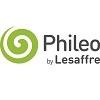
Content sponsored by:
Phileo by Lesaffre
Comparison of live yeast and zinc on the occurrence of pathogenic E. coli in weaned piglets
Published: August 14, 2019
By: Geraldine KUHN – Phileo by Lesaffre
Enterotoxigenic E. coli (ETEC) can cause significant digestive disorders in postweaning piglets. Modern strategies are searched, how to replace antibiotics and ZnO as a feed additives. Some studies suggested that live yeasts Saccharomyces cerevisiae may help protect piglets against an ETEC infection. Probiotics, including live yeast and lactic acid bacteria cultures, have been reported to improve performance of weaned piglets. Piglets fed milk replacer supplemented with Saccharomyces cerevisiae Sc 47 (SC) showed an increased postweaning growth and reduced TNF-α expression in the intestinal and liver tissues, suggesting an important immunomodulatory role of the combined treatment. This is in accordance with anti-inflammatory effects generally reported following yeast supplementation. The objective of this study was to evaluate the effect of SC dietary supplementation and compare it to ZnO supplemented feed and mixed SC and ZnO supplemented feed on the presence of ETEC strains in faeces, general signs of diarrhoea and performance of postweaning piglets.
Material and Methods
Two studies were conducted in sows farm. The first study included 3 successive batches of 200 piglets from weaning at 25 days of age to the end of the post-weaning period (80 days of age). The treatment groups are as followed: the first batch of piglets (Yeast group) received the Starter diet supplemented with live yeast at 1kg/t. The second batch received the Starter diet supplemented with ZnO (ZnO group) at 3000 ppm, the third batch received the yeast unsupplemented Starter diet (Control group). The piglets were individually weighed (at beginning and end of PW period), weekly rectal samples (ETEC cultivation + verotoxigenic E. coli) and daily diarrhea score were noticed.
For the 2nd study, performance was compared before (ZnO group) and after supplementation (Yeast).
Main results
Diarrhea scores: The Control piglets showed increased diarrhoea scores from Day 2 post weaning. The piglets treated with SC and/or ZnO did not show any prominently increased diarrhoea scores for the whole experimental period (Figure 1). Bacteriological findings: Control group reached highest ETEC capture score in swabs (average 40 %, SD 46,4), the second highest score received Zn group (Avg 20%, SD 37,7); and lower prevalence occurred at SC group (Avg 1 %, SD 3,16) at Day 6. Zootechnical performance: The SC and/or Zn treated batches had double mean weight gain (without significant differences among them) in compare to Control batch.

Same performance is observed in the 2nd experiment: reduction of diarrheoa, weight gain and FCR.
Conclusion and Discussion
The present studies confirm the improvement of sanitary status of piglets. This improvement may be linked to reduced E.coli infection in yeast probiotic supplemented animals. The result approved yeast as a possible replacement of zinc in feed supplementation and post weaning diarrhoea prevention. In conclusion, the present study clearly demonstrates positive impact of Sc47 on ETEC induced diarrhoea under field conditions.
References
Trckova M. et al., 2014. The effects of live yeast Sc on postweaning diarrhea, immune response, and growth performance in weaned piglets. J. Anim. Sci., 92, 767–774.
Trevisi P., et al., 2015. J. Anim. Sci., 93, 2225–2233
Related topics
Authors:
Join to be able to comment.
Once you join Engormix, you will be able to participate in all content and forums.
* Required information
Would you like to discuss another topic? Create a new post to engage with experts in the community.
Create a post
.jpg&w=3840&q=75)